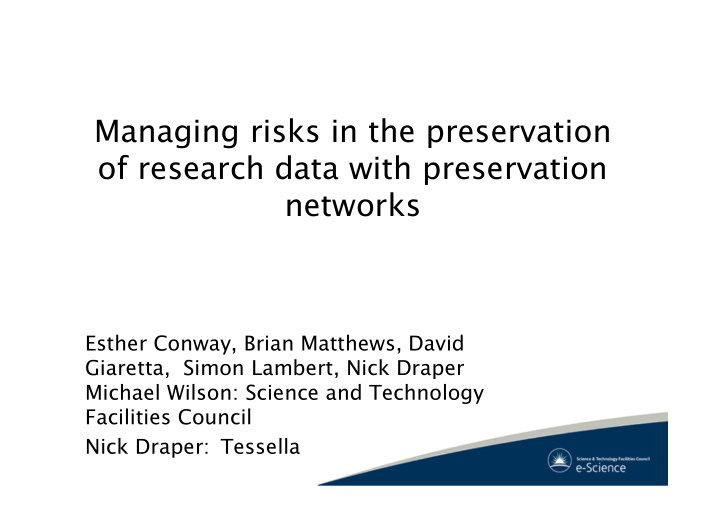



Managing risks in the preservation of research data with preservation networks Esther Conway, Brian Matthews, David Giaretta, Simon Lambert, Nick Draper Michael Wilson: Science and Technology Facilities Council Nick Draper: Tessella
RAL Diamond Light Source Central Laser Facility RAL Space ISIS
E-Science supports the science lifecycle
EU Projects FP6 FP7 • CASPAR • APARSEN • PARSE INSIGHT • SCAPE • ENSURE • SCIDIP
Objects Objects are uniquely identified digital entities capable of an independent existence which possess the following attributes: Information is a description of the key information contained by the digital object. This information should have been identified during preservation analysis as being the information required to satisfy the preservation objective for the designated user community. Location information is the information required by the end user to physically locate and retrieve the object. Archival Information Packages (AIPs) may be logical in construction with key digital objects being distributed and managed within different information systems. This tends to be the case when data is in active use with resources moving in dynamic environment. Note the difference between being able to locate and retrieve information and having control of it. Physical state describes the form of the digital object. It should contain sufficient information relating to the version, variant, instance or format. A PNM terminates when a user requires no additional information or assistance to achieve the defined preservation objective, given that the accepted risks will not be imminently realised.
Relationship A relationship captures how two objects are related to one another in order to fulfil the specified preservation objective whilst being utilized by a member of the designated user community. Relationships can possess the following attributes: Function , in order to satisfy the preservation objective a digital object, will perform a specific function for example the delivery of textual information or the extraction and graphical visualisation of specific parameters. Risks and Dependencies , most digital solutions will have inherent risks and a finite lifespan. Risks could include the interpretability of information, technical dependencies or loss designated community skills. Risks should be recorded against the appropriate object so they can be monitored and the implication of them being realised assessed. Tolerance , not every function is critical for the fulfilment of the preservation objective, some objects are included as they enhance the quality of the solution or ease of use. Loss of this function is denoted in the model as a tolerance. Quality assurance and testing, The ability of an object to perform the specified function may have been subjected to quality assurance and testing which may be recorded against the relationship.
Cost and Value: Evaluate the cost and benefit of different quality solutions, enabling a business to choose the most cost effective solution. Preservation Lifecyle Management: Build on industry standard lifecycle management approaches to manage the preservation lifecycle, meet regulatory compliance, allow changes in the preservation approach to reflect environmental changes, address evolution of ontologies and manage the quality of digital objects over time. Content-aware Long Term Data Protection: Provide data protection over long periods of time, addressing changes to personally identifiable information, new and evolving regulations, and manage user identities over the decades. Utilize Emerging ICT: Evaluate the costs, risks and benefits and demonstrate how to use emerging, commonly available Information Technology to enable scalable solutions for digital preservation, in particular considering Cloud Storage and virtualization techniques .
Data Preservation Preservation Business Monitor Preservation Case Actions external events Pre- Discover & Preservation archive Archive data access data Planning phase Preservation Fixity Actions Checks
Preservation is all about control
Preservation Action Risk Acceptance and Monitoring • Software Capture • Description • Transformation •
Technology Agnostic but Expensive !!!!!
ISIS Instruments
ISIS techniques Muon spectroscopy Neutron diffraction Neutron spectroscopy Reflectometry Small Angle scattering Finding the structure and properties of chemicals To make new materials, drugs etc..
Permits Automated Assessments • Cost • Value • Risk • Benefit
Added Benefits • Assess exposure to risk and longevity of solutions • Impact analysis based on risk realisation • Tailoring solutions that are responsive to evolving environments • Tailoring solutions that are responsive to evolving environments • Scalability through characterising data collections •
Interesting Questions For Us? • Risk Profiling • Benefits and Performance • Cost and Re-use of Solutions • Quality and Trust
Questions From You? esther.conway@stfc.ac.uk
Recommend
More recommend